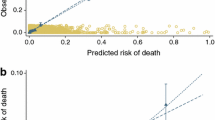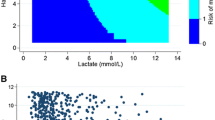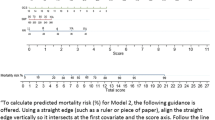Abstract
Scoring systems provide a means for comparing results, ensuring consistent standards and evaluating changes in therapy. The APACHE II system depends partly on the results of laboratory tests which are not normally available in Central Africa. The aim of this study was to develop a scoring system based only on clinical observations. Six hundred and twenty-four consecutive admissions to the intensive care unit (ICU) were allocated a clinical sickness score (CSS) according to pulse rate, blood pressure, respiration rate, urine output, Glasgow Coma Scale, temperature and age. CSS was significantly associated with outcome, there being no significant difference between actual and predicted outcomes calculated by logistic regression analysis. There was a significant difference between mean scores for survivors and non-survivors in all diagnostic groups except diabetes. The proportional change in score from admission was also significantly associated with outcome on each subsequent day in ICU. The CSS provides an objective measure of illness severity for critically ill patients in Africa.
Similar content being viewed by others
References
Watters DAK, Sinclair JR (1988) Outcome of severe head injuries in Central Africa. J R Coll Surg Edinburgh 33:35–38
Sinclair JR, Watters DAK, Bagshawe A, (1989) Outcome of nontraumatic coma in Zambia. Trop Doct 19:6–10
Sinclair JR, Watters DAK (1988) Outcome of mechanical ventilation in central Africa. Ann R Coll Surg Engl 70:76–79
Jennet B (1984) Inappropriate use of intensive care. Br Med J 289:1709–1711
Knaus WA (1986) Rationing, justice and the American physician. JAMA 255:1176–1177
Detsky AS, Stricker SC, Mulley AG, Thibault GE (1981) Prognosis, survival and the expenditure of hospital resources for patients in an intensive care unit. N Eng J Med 305:667–672
Engelhardt HT, Rie MA (1986) Intensive care units, scarce resources and conflicting principles of justice. JAMA 255:1159–1164
Knaus WA, Draper WA, Wagner DP, Zimmerman JE (1985) Apache II: a severity of disease classification system. Crit Care Med 13:818–829
Wagner DP, Knaus WA, Draper EA (1986) Physiologic abnormalities and outcome from acute disease. Arch Int Med 146:1289
Knaus WA, Wagner DP, Loirat P (1983) A comparison of intensive care in the USA and France. Lancet II:642–646
Knaus WA, Draper EA, Wagner DP (1982) Evaluating outcome from intensive care: a preliminary multihospital comparison. Crit Care Med 10:491–496
Gustafson DH, Fryback D, Rose J (1981) Decision: theoretical methodology for severity index development. Madison WI, Center for Health Systems Research and Analysis, University of Wisconsin
Searle JE (1985) The outcome of mechanical ventilation; report of a five year study. Ann R Coll Surg Engl 67:187–189
Nunn FJ, Milledge JS, Singaraya J (1979) Survival of patients ventilated in an intensive therapy unit. Br Med J 279:1525–1527
Teasdale G, Jennett B (1974) Assessment of coma and impaired consciousness. Lancet II:81–84
Jennett B, Teasdale G, Braakman R, Minderhoud J, Heiden J, Kurze T (1980) Prognosis of patients with severe head injury. J Neurol Neurosurg Psychiatry 43:289–295
Miller ES, Neoptolemos JP, Aitkenhead AR, Fossard DP (1985) Management of severe head injuries in a non-neurosurgical centre. J R Coll Surg Edinburgh 30:82–87
Levy DE, Bates D, Carona JJ (1981) Prognosis in non-traumatic coma. Ann Int Med 94:293–301
Levy DE, Carona JJ, Singer BH, Lapinski RH, Frydman H, Plum F (1985) Predicing outcome from hypoxic-ischaemic coma. JAMA 253:1420–1426
Watters DAK, Sinclair JR, Luo N, Verma R (1988) HIV seroprevalence in critically ill patients in Zambia. AIDS 2:142–143
Bion JF, Aitchison TC, Edlin SA, Ledingham IMcA (1988) Sickness scoring and response to treatment as predictors of outcome from critical illness. Intensive Care Med 14:167–172
Author information
Authors and Affiliations
Rights and permissions
About this article
Cite this article
Watters, D.A.K., Wilson, I.H., Sinclair, J.R. et al. A clinical sickness score for the critically ill in Central Africa. Intensive Care Med 15, 467–470 (1989). https://doi.org/10.1007/BF00255604
Received:
Accepted:
Issue Date:
DOI: https://doi.org/10.1007/BF00255604




